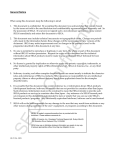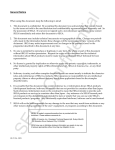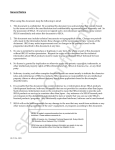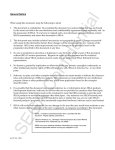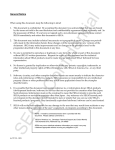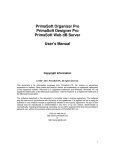Download SEGA Confidential
Transcript
When using this document, keep the following in mind: nti al General Notice 1. This document is confidential. By accepting this document you acknowledge that you are bound by the terms set forth in the non-disclosure and confidentiality agreement signed separately and /in the possession of SEGA. If you have not signed such a non-disclosure agreement, please contact SEGA immediately and return this document to SEGA. de 2. This document may include technical inaccuracies or typographical errors. Changes are periodically made to the information herein; these changes will be incorporated in new versions of the document. SEGA may make improvements and/or changes in the product(s) and/or the program(s) described in this document at any time. nfi 3. No one is permitted to reproduce or duplicate, in any form, the whole or part of this document without SEGA’S written permission. Request for copies of this document and for technical information about SEGA products must be made to your authorized SEGA Technical Services representative. 4. No license is granted by implication or otherwise under any patents, copyrights, trademarks, or other intellectual property rights of SEGA Enterprises, Ltd., SEGA of America, Inc., or any third party. Co 5. Software, circuitry, and other examples described herein are meant merely to indicate the characteristics and performance of SEGA’s products. SEGA assumes no responsibility for any intellectual property claims or other problems that may result from applications based on the examples describe herein. GA 6. It is possible that this document may contain reference to, or information about, SEGA products (development hardware/software) or services that are not provided in countries other than Japan. Such references/information must not be construed to mean that SEGA intends to provide such SEGA products or services in countries other than Japan. Any reference of a SEGA licensed product/program in this document is not intended to state or simply that you can use only SEGA’s licensed products/programs. Any functionally equivalent hardware/software can be used instead. 7. SEGA will not be held responsible for any damage to the user that may result from accidents or any other reasons during operation of the user’s equipment, or programs according to this document. SE NOTE: A reader's comment/correction form is provided with this document. Please address comments to : SEGA of America, Inc., Developer Technical Support (att. Evelyn Merritt) 150 Shoreline Drive, Redwood City, CA 94065 SEGA may use or distribute whatever information you supply in any way it believes appropriate without incurring any obligation to you. (11/2/94- 002) SE GA Co nfi de nti al TM The SATURN SCU DSP Assembler User's Manual Addendum Doc. # ST-240-A-SP1-052295 © 1994-95 SEGA. All Rights Reserved. nti al READER CORRECTION/COMMENT SHEET Keep us updated! If you should come across any incorrect or outdated information while reading through the attached document, or come up with any questions or comments, please let us know so that we can make the required changes in subsequent revisions. Simply fill out all information below and return this form to the Developer Technical Support Manager at the address below. Please make more copies of this form if more space is needed. Thank you. General Information: Phone de Your Name Document number ST-240-A-SP1-052295 Document name The SATURN SCU DSP Assembler User's Manual Addendum Corrections: Correction nfi pg. # GA Co Chpt. Date SE Questions/comments: Fax: Where to send your corrections: (415) 802-1717 Attn: Evelyn Merritt, Developer Technical Support Mail: SEGA OF AMERICA Attn: Evelyn Merritt, Developer Technical Support 150 Shoreline Dr. Redwood City, CA 94065 nti al The SATURN SCU DSP Assembler User's Manual Addendum by Dennis Caswell 5/1/95 Introduction Invoking theAssembler The syntax for invoking the assembler is: de The DSP assembler (dspasm.exe) assembles programs written for the DSP that is a part of the SATURN System Control Unit (SCU). It produces object files in S-record format, in Hitachi assembler source format, and in C source format. dspasm [<options>] <source file> [<object file>] nfi If the <object file> is omitted, the assembler will produce an object file with the same name as the source file and the extension “.s”. Command Line Options Output the DSP program as an assembler source file having the extension “.d” in addition to the S-record object file, which is always produced. The file is in Hitachi format, and it consists of a series of .DATA.L statements. /c Output the DSP program as a C source file having the extension “.d” in addition to the Srecord object file, which is always produced. The file contains a comma-separated list of 32bit hexadecimal numbers which can be used in an array initializer. /l Output an assembled listing having the extension “.lst” in addition to the S-record object file, which is always produced. /m Enables midbox (Model M) compatibility mode. GA Co /a These options may be invoked with either a slash or a minus sign, and they may be used in combination with one another. Source File Format SE Each line of a DSP assembler source file has the following format. [<label>] [<opcode> [<operand list>]] ... [<comment>] Either spaces or tabs may be used as separators. Labels need not begin in column 1 (however, see “Labels,” below), and opcodes must not begin in column 1. Comments begin with a semicolon and continue to the end of the line. A backslash may be used as a continuation character at the end of a source line, allowing a long logical line to be broken into several physical lines. In order to continue a line which contains a comment, the continuation character must immediately precede the semicolon. The SATURN SCU DSP Assembler User's Manual Addendum 1 nti al The maximum line length is 255 characters. The assembler does not distinguish between upper and lower case. Labels Labels consist of up to 32 letters, numbers, and/or underscores. The first character of a label may not be a number. A label on an instruction need not begin in column 1, but, if it doesn’t, it must be appended by a colon. If the label does begin in column 1, the colon is optional. Reserved Words de The following symbols are reserved and should not be used as labels: ALH, ALL, ALU, M0, M1, M2, M3, MC0, MC1, MC2, MC3, MUL. Using these symbols as labels will not generate an error message in all cases, but it may cause your code to be assembled in ways you probably didn’t expect. The assembler recognizes the following opcodes. nfi Opcodes Operation commands: MOV, ADD, SUB, AD2, AND, OR, XOR, SR, RR, SL, RL, RL8, CLR, NOP Load Immediate command: MVI Jump command: JMP Looping commands: BTM, LPS End commands: END, ENDI Co DMA commands: DMA, DMAH GA Normally, at most one opcode appears on each source line, however, up to six operation commands may appear on a single source line, subject to the DSP’s hardware limitations (see the programming examples at the end of this manual). Assembler Directives ELSE Concludes an IF directive. SE ENDIF Concludes an IF clause and begins an ELSE clause. If the expression in the preceding IF directive was zero, then the statements between the ELSE directive and the next ENDIF directive will be assembled; otherwise, they will be ignored. ENDS Causes the assembler to ignore everything from this directive to the end of the file. EQU Equates a label with a constant, e.g. foo equ 1. 2 nti al IF <expr>|<label> If the expression or label is non-zero, then the statements between the IF directive and the next ENDIF or ELSE directive will be assembled; otherwise, they will be ignored. IF directives may be nested up to 16 levels deep. If the given label has been defined, then the statements between the IFDEF directive and the next ENDIF or ELSE directive will be assembled; otherwise, they will be ignored. ORG Set the assembler’s target address, e.g. org 0. The directive has no effect on the contents of the C and assembler object files apart from altering the comments that show the target addresses. = Equivalent to EQU. de IFDEF <label> Constants, Expressions, and Operator Precedence nfi Numerical literals are decimal by default. Hexadecimal literals must be preceded by a dollar sign. Binary literals must be preceded by a percent sign. Constants and labels may be combined in expressions using the following operators, which are listed in the order of their precedence. Unary plus, unary minus, and bitwise negation. Multiplication, division, and modulus. Addition and subtraction. Left and right shifting. Bitwise and. Bitwise or and exclusive or. Notes Co +, -, ~ *, /, % +, <<, >> & |, ^ GA The DSP’s program memory is limited to 256 words, but the assembler will assemble programs having up to 2048 words, and the DSP simulator will load and run them. This allows you to develop and debug your algorithms first and worry about program size later. If your program exceeds 256 words in length, a warning will be displayed. Use caution, however, since jumping to destinations beyond the 256-word boundary will not work, because the destination field in a JMP command is only eight bits wide. SE The assembler stops as soon as it encounters an error, so it never generates more than one error message. The SATURN SCU DSP Assembler User's Manual Addendum 3 Sample Programs mov mov mov lps mov endi ; ; ; ram0_index,ct0 ; ram1_index,ct1 ; block_size-1,lop ; ; mc0,mc1 ; ; 2a. Calculating (2x3) + (4x5) without parallelism. ; ; ; ram0_index,ct0 ram1_index,ct1 #2,mc0 #3,mc1 #4,mc0 #5,mc1 ram0_index,ct0 ram1_index,ct1 ram2_index,ct2 mc0,x mc1,y mul,p mc0,x mc1,y a mov alu,a mul,p mov all,mc2 ; ; ; ; ; ; ; ; ; ; ; ; ; ; ; ; ; ; ; GA mov mov mvi mvi mvi mvi mov mov mov mov mov mov mov mov clr ad2 mov ad2 endi 0 0 0 Load index register for R0. Load index register for R1. Initialize loop counter. Repeat next instruction. Move a word from R0 to R1, autoincrementing the index registers. Index to location of 2 and 4 in R0. Index to location of 3 and 5 in R1. Index to location of result in R2. Load index register for R0. Load index register for R1. Store 2 in the first word of R0. Store 3 in the first word of R1. Store 4 in the second word of R0. Store 5 in the second word of R1. Reset R0 index. Reset R1 index. Load index to destination buffer in R2. Load the 2 into the RX register. Load the 3 into the RY register. Move the product into the P register. Load the 4 into the RX register. Load the 5 into the RY register. Clear the accumulator. Add the P register to the accumulator. Move the second product into P. Add the two products and store the result in R2. Co ram0_index = ram1_index = ram2_index = Number of words to be copied. Index to start of source data in R0. Index to destination buffer in R1. de 12 0 0 nfi block_size = ram0_index = ram1_index = nti al 1. Copying a block of memory from RAM0 to RAM1. 2b. Calculating (2x3) + (4x5) with parallelism. 0 0 0 SE ram0_index = ram1_index = ram2_index = mvi mvi mvi mvi 4 #2,mc0 #3,mc1 #4,mc0 #5,mc1 ; ; ; Index to location of 2 and 4 in R0. Index to location of 3 and 5 in R1. Index to location of result in R2. mov ram0_index,ct0 mov ram1_index,ct1 ad2 ad2 endi mov mc1,Y mov mc1,Y mov mul,p mov mul,p clr a mov alu,a mov all,mc2 3. Multiplication of a 4x3 matrix by a 4-element vector. Perform a typical 3D point-transformation calculation: = | x1 | | y1 | | z1 | de | m00 m01 m02 m03 | | x0 | | m10 m11 m12 m13 | * | y0 | | m20 m21 m22 m23 | | z0 | | 1 | We assume that the matrix is already present in RAM0. The vector will be loaded into RAM1 using DMA. The resultant vector will be stored in RAM2. The address of the input vector in external memory is divided by four, because addresses in the DMA read register (RA0) get multiplied by four before being sent out onto the system bus. nfi ; ; ; ; ; ; ; ; ; ; ; ; ; nti al mov mc0,X mov mc0,X mov ram0_index,ct0 mov ram1_index,ct1 mov ram2_index,ct2 SE GA Co ; vector_adr = $10000 >> 2 in_mat_r0 = 0 in_vec_r1 = 0 out_vec_r2 = 0 ; ; Transfer the x0, y0, and z0 from external memory to RAM1. ; mvi #vector_adr,ra0 mov in_vec_r1,ct1 dma d0,mc1,#3 ; ; Wait for the transfer to complete. ; dma_wait: jmp t0,dma_wait ; ; Initialize the data RAM index registers. ; mov in_mat_r0,ct0 mov in_vec_r1,ct1 ; The SATURN SCU DSP Assembler User's Manual Addendum 5 Start computing sums of products and storing the results. mul,p mul,p mul,p mul,p mul,p mul,p mul,p mul,p mul,p mul,p mul,p mul,p mov mov mov mov mov mov mov mov mov mov mov mov mc0,y mc0,y mc0,y mc0,y mc0,y mc0,y mc0,y mc0,y mc0,y mc0,y mc0,y mc0,y mov out_vec_r2,ct2 clr mov mov mov clr mov mov mov clr mov mov mov nti al mov mov mov mov mov mov mov mov mov mov mov mov a alu,a alu,a alu,a a alu,a alu,a alu,a a alu,a alu,a alu,a Co GA SE 6 mov in_vec_r1,ct1 mov #1,rx mov all,mc2 mov in_vec_r1,ct1 mov #1,rx mov all,mc2 mov #1,rx mov all,mc2 nfi mov mc1,x mov mc1,x ad2 mov mc1,x ad2 ad2 mov mc1,x ad2 mov mc1,x ad2 mov mc1,x ad2 ad2 mov mc1,x ad2 mov mc1,x ad2 mov mc1,x ad2 ad2 ad2 endi de ; ;









